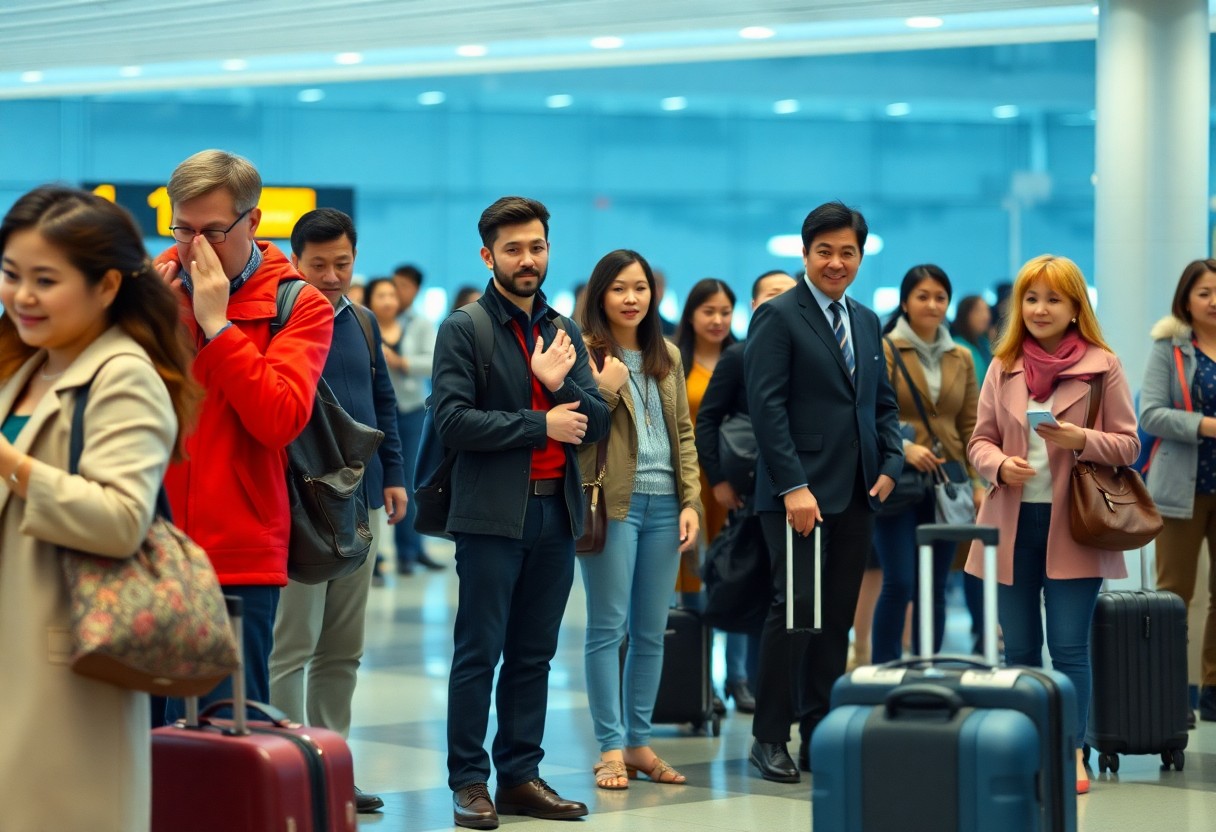Traveling opens you up to diverse cultures and unique experiences, but it also brings the responsibility of understanding local customs to ensure respectful interactions. Ignoring obscure etiquette rules can lead to uncomfortable situations or misunderstandings, threatening to mar your adventure. From dining behaviors to dress codes, being aware of these subtleties can significantly enhance your travel experience and foster positive connections with locals. Dive into this guide to discover what you need to know to elevate your journey beyond mere sightseeing.
Key Takeaways:
- Greetings: Familiarize yourself with local greeting customs, including handshakes, hugs, or bows, as they can differ significantly from one culture to another.
- Tipping: Understand the tipping etiquette in your destination, as it may vary greatly—some places may consider tipping rude, while in others it’s expected.
- Dining Etiquette: Be aware of local dining norms, such as which utensils to use or how to engage in conversation during meals, as following these can enhance your experience.
How to Navigate Cultural Differences
To travel successfully in diverse countries, you must navigate cultural differences with care and respect. Each destination has its own customs and norms, and being aware of them can help you avoid misunderstandings and demonstrate your appreciation for local cultures. Engaging with locals and observing their behavior will go a long way in helping you blend in and enhance your travel experience.
Understanding Local Customs
On your journey, it’s vital to familiarize yourself with the local customs of the places you visit. This includes knowledge of greetings, dining etiquette, and holiday practices. Researching these customs before your trip allows you to interact politely and authentically with the locals, fostering a deeper connection to the culture and enhancing your travel experience.
Recognizing Non-Verbal Communication
Differences in non-verbal communication can greatly affect your interactions while traveling. Awareness of body language, facial expressions, and personal space varies widely around the globe. For example, direct eye contact might be perceived as confidence in some cultures but could be considered rude or aggressive in others. Being cautious about your gestures and maintaining a respectful demeanor can help you navigate social situations effectively.
With non-verbal cues, you may find that what is acceptable in one culture may be offensive in another. Understanding gestures, such as thumbs-up or the peace sign, is imperative, as these can convey entirely different meanings. Pay attention to the personal space norms in different countries; being too close may feel intrusive, while too much distance might seem cold. By observing and adapting to the local non-verbal communication styles, you can significantly improve your interactions, build rapport, and foster goodwill with the people you meet during your travels.
Tips for Dining Etiquette
There’s much more to dining etiquette than just how to use utensils. Whether you’re navigating fine dining or casual meals, observe these basic practices:
- Keep your elbows off the table.
- Wait for the host to start the meal.
- Use the correct utensils for each course.
- Don’t speak with your mouth full.
- Limit phone usage to avoid distractions.
Recognizing these nuances can enhance your dining experience and reflect positively on you.
Table Manners Abroad
You may find table manners vary significantly across cultures. In some countries, finishing everything on your plate is a compliment to the chef, while in others, leaving food indicates you’ve had enough. Understanding and adapting to these differences will help you show respect to your hosts and make your meals more enjoyable.
Tipping Practices in Various Countries
If you want to navigate tipping practices while traveling, it’s vital to know the local norms. Tipping can vary widely—from being included in the bill to being strongly encouraged or even offensive. In Japan, for instance, it’s often better to avoid tipping altogether, while in the US, a 15-20% tip is standard.
The approach to tipping is shaped by cultural values. In some regions, like Europe, service charges may be included, making additional tips unnecessary. On the other hand, in places like Mexico, leaving a small amount can be appreciated. Always check the local customs to avoid missteps. In countries where it can be perceived as offensive, like Japan, avoid tipping or doing so may be considered disrespectful. Knowing whether to tip or not can greatly impact your interactions, so investing time in research is worthwhile.
Factors Influencing Dress Codes
Not every destination has the same expectations when it comes to dress codes. Various factors can play a significant role, including:
- Culture
- Climate
- Activities
- Occasions
Recognizing these influences helps you choose appropriate attire for your travels.
Appropriate Attire for Different Cultures
You should be aware that every culture has its own standards of what is considered appropriate attire. Factors such as local customs and traditions can dictate everything from modesty to color significance. For example, certain societies may favor conservative clothing, while others might embrace vibrant styles. Being knowledgeable and respectful of these differences enhances your travel experience and promotes intercultural understanding.
Adjusting Clothing for Religious Sites
There’s a need for heightened awareness when visiting religious sites, as many require specific standards of modesty. You may be asked to cover your arms, legs, or head; thus, packing layers or breathable wraps is vital. Different religions have unique dress etiquette, and respecting these guidelines shows reverence for the sacred environment.
Sites such as temples, churches, and mosques often have strict dress codes that can include prohibitions on shorts, tank tops, and exposed shoulders. In some cases, failing to adhere to these rules may result in denied entry, making it vital to adjust your wardrobe accordingly. Notably, while some locations may offer rental garments, it’s advisable to arrive prepared with your own modest clothing. Doing so not only ensures compliance but also reflects a positive attitude toward local customs and appreciation for the site’s cultural significance.
How to Interact Respectfully
Now that you are ready to explore the world, understanding how to interact respectfully with locals is crucial. Each culture has its unique social customs and practices that dictate how to engage with others. By being aware of these nuances, you not only show respect but also enhance your travel experience and foster positive connections with those you meet along the way.
Greeting Protocols
Even though a simple “hello” may suffice in some areas, many cultures have specific greeting protocols that reflect their traditions and values. In some countries, a firm handshake is appreciated, while in others, a bow or cheek kiss may be more appropriate. Take a moment to observe how locals greet each other, and follow suit to ensure a warm and respectful introduction.
The Importance of Politeness
Even the smallest acts of politeness can significantly impact your interactions while traveling. Being courteous and respectful reinforces goodwill and helps you build rapport with locals. Simple phrases like “please,” “thank you,” and “excuse me” can go a long way in conveying your appreciation and fostering a friendly atmosphere.
Another way to demonstrate your politeness is by being attentive to cultural norms regarding conversation. For instance, in some societies, interrupting someone may be seen as rude. Additionally, using appropriate body language can contribute to overall respect. Showing genuine interest in local customs and making an effort to adhere to them can lead to more meaningful exchanges and create lasting friendships. Your positive demeanor not only reflects well on you but also leaves a lasting impression on those you interact with.
Tips for Using Public Transportation
Despite the hustle and bustle of public transportation, following some etiquette rules can enhance your experience. Here are a few key guidelines to keep in mind:
- Offer your seat to those who need it more, like the elderly or disabled.
- Keep conversation volume low to respect fellow passengers.
- Stay clear of doorways and walkways to allow for easier movement.
- Avoid eating strong-smelling foods that may disturb others.
After understanding these tips, you can dive deeper into the world of proper 12 Travel Etiquette Tips You Need to Know.
General Etiquette on Buses and Trains
While riding buses and trains, it’s important to be considerate of your fellow passengers. Avoid loud phone calls and use headphones when listening to music. Keep your belongings close and don’t occupy extra seats with your bags. Most importantly, wait for passengers to dislaunch before you board, promoting a smoother transit for everyone.
Navigating Social Norms in Shared Spaces
You should always be aware of the social norms that govern shared transportation spaces. Each region has its own rules; for instance, in some cultures, talking to strangers is welcome, while in others, it might be seen as intrusive.
The dynamics of shared spaces can therefore vary greatly, making it important that you observe and adapt to your surroundings. Avoid making sudden movements that might invade someone’s personal space, as this could lead to discomfort. Be polite and acknowledge the different customs—some individuals may appreciate friendly conversation, while others prefer silence. Finally, respecting personal boundaries is vital for a peaceful and safe journey for everyone involved.
Factors Influencing Photography Etiquette
All travelers should be mindful of several factors that influence photography etiquette. Consider the following points:
- Your subject’s privacy and comfort
- The cultural significance of the location
- Local laws regarding photography
- The potential impact on the environment
Recognizing these aspects will help you navigate photography more respectfully and responsibly while traveling.
When to Ask for Permission
Clearly, asking for permission before taking someone’s photo is necessary in many situations. This is especially true for candid shots, where the subject may not be aware that they are being photographed. Being polite and respectful can open doors to positive interactions and even richer experiences.
Respecting Cultural Sensitivities
Cultural understanding is vital in photography. You may encounter places where taking photos is considered inappropriate or disrespectful. Each culture has its own customs, and it’s integral that you educate yourself about these nuances before snapping pictures.
The guidelines for photography can vary greatly; for instance, religious sites might have strict rules about photography, while in some communities, portrait photography might only be permitted if you seek the subject’s consent. Always be aware that certain gestures, such as pointing a camera at individuals or sacred objects, can be perceived as offensive. Respecting these cultural boundaries not only enhances your experience but also guarantees a more positive relationship with local communities.
Final Words
Now that you’re equipped with some lesser-known etiquette rules, you can enhance your travel experience and show respect to the cultures you encounter. From understanding local dining customs to acknowledging appropriate gestures, your awareness will go a long way in forging positive connections. By being mindful of these subtleties, you not only enrich your journey but also foster goodwill with locals, making your travels more enjoyable and rewarding.
Q: What are some lesser-known dining etiquette rules when traveling abroad?
A: Dining etiquette can vary significantly from one culture to another. In Japan, for instance, it is considered impolite to stick your chopsticks upright in a bowl of rice, as this action resembles a funeral rite. In Italy, never ask for extra cheese on your pasta, as it can be deemed disrespectful to the chef’s craftsmanship. Additionally, in many Middle Eastern countries, it is customary to eat with your right hand only, as the left hand is associated with uncleanliness. Understanding these subtle nuances can enhance your dining experience and show respect for local customs.
Q: Are there specific greeting customs that travelers should be aware of?
A: Greetings can be an important part of interactions in different regions. In many Asian cultures, a slight bow is a common greeting instead of a handshake. For instance, in Thailand, a ‘wai’ or pressed hands gesture accompanied by a slight bow is traditional. In contrast, in many parts of Europe, a firm handshake is the norm, while in some Latin American countries, individuals often greet each other with a kiss on the cheek. Being aware of and practicing these greetings can help establish rapport and show a genuine interest in the culture.
Q: What are some common taboos that travelers should avoid while visiting other countries?
A: Every country has its customs and taboos that travelers should be cautious about. For example, in many Middle Eastern cultures, it’s considered disrespectful to show the soles of your feet, as they are seen as the dirtiest part of the body. Similarly, in some cultures, discussing personal matters or asking about one’s salary can be deemed intrusive. Moreover, in countries like Brazil, touching someone on the back or shoulder can be seen as inappropriate due to personal space preferences. To avoid offending locals, it’s wise to educate yourself on these sensitivities before visiting a new destination.









